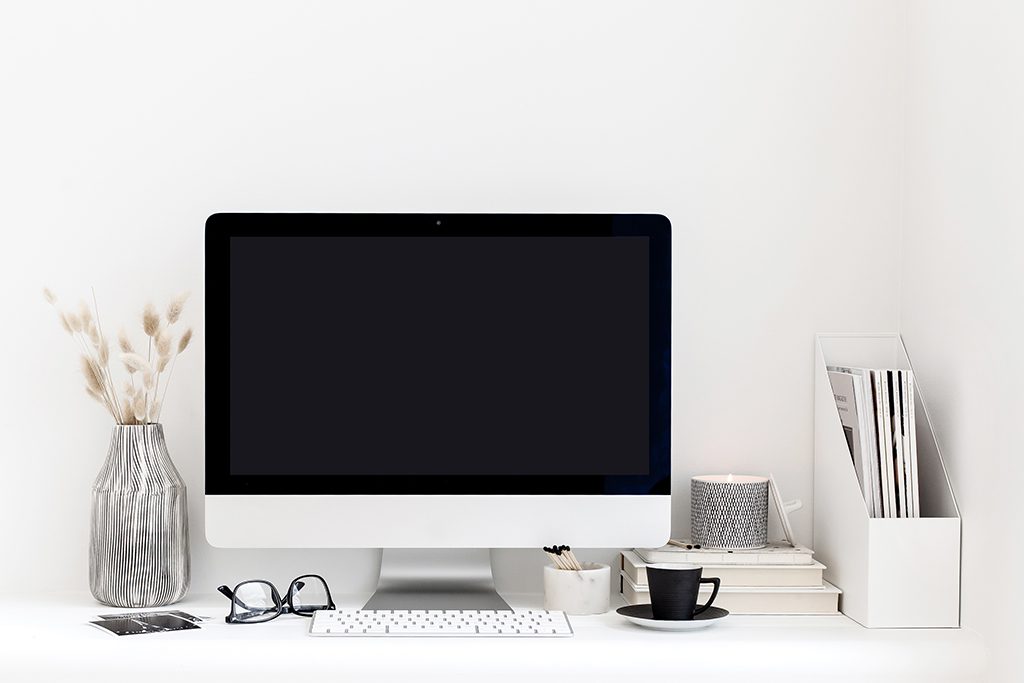
Put a hand up if you love a new year. I love the fresh start, the new beginning and the chance to right the previous wrongs. Usually so much of our effort is spent on improving our personal selves. Instead of trying to focus on superficial goals that can end up making you feel worse about yourself, let’s make a commitment to build a better business this year.
If you really want to have an impact on your business your first step is creating a workflow. This is always the first thing that I work on with my consulting clients. Why? Because clarity is the key to making real change.
WHAT IS A WORKFLOW?
A workflow is a roadmap that outlines the tasks you’ll take with each new client. It’s related to your operations and not your design work.
There are repeatable and repetitive actions we take with each client. A workflow map will allow you to organize and connect the tasks from each client stage, from inquiry to offboarding and record them to be used as a template for each new client project.
Almost every designer I know feels confident in their design skills but lacking in the knowledge of how to run the operations aspect of business.
If you feel like you’re currently drowning in your business I can almost guarantee you aren’t following a roadmap.
I can hear some of you objecting and saying “I’m a creative. I don’t work like that”. As a designer you are absolutely a creative but as a business owner you need to organize your operations in order to be successful.
WHAT IS THE PURPOSE OF A WORKFLOW?
Your workflow creates the step-by-step structure of how you walk a client from inquiry to offboarding.
This is the document that will be used in your business to create structure. Once it’s been finalized this becomes the blueprint for creating your processes and systems.
If you want to get better at running your business this is the first and most crucial step you can take.
HOW TO START CREATING A WORKFLOW IN YOUR DESIGN BUSINESS?
The designs you create for clients are unique and will look different from client to client. Conversely, your client operations should not be unique. You should have repeatable processes and tasks that you go through with every new client.
STEP 1 – The way to start is to grab paper and pen and start writing out the steps you currently take when you bring a new client into your business. Ask yourself questions and do a brain dump of information.
- How long is a discovery call? What is the next step after the call?
- What happens during the onboarding meeting? What documentation is the client expected to provide?
- Who attends trade day? What is the follow up process for discussing issues brought up by trades?
- What’s included in the first design presentation? How long will that meeting last?
- How are revisions dealt with?
STEP 2 – Once you have written down everything you can think of you can begin to organize the information into sections. I recommend dividing your work into the following phases to keep things more organized:
- Inquiry phase
- Discovery call
- Consultation
- Onboarding
- Design phase
- Ordering & procurement (if you do that work)
- Furniture & decor (if you do that work)
- Offboarding
STEP 3 – Start to allocate the tasks to the appropriate section, ie full review of contract with client could be included in the consultation or onboarding phase.
Include details like who will this task be assigned to, how long is the waiting period, ie how long does a client have before the contract needs to be signed?
Lastly what are the results and where do the results lead? ie, if contract isn’t signed and returned in 3 days a follow up call will be made by senior designer. If contract is signed and returned, move to next step.
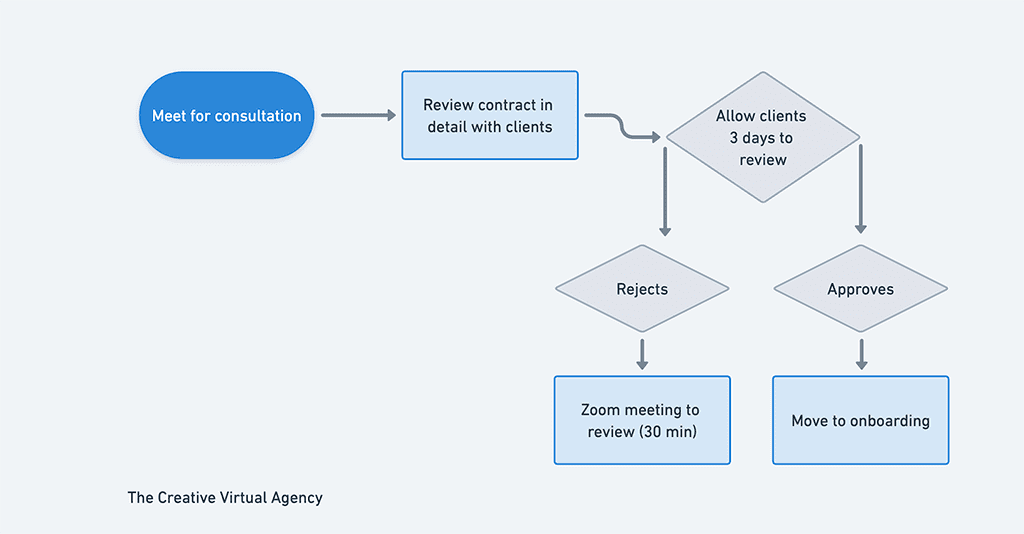
WHAT DOES A WORKFLOW LOOK LIKE?
Depending on your industry the look and feel of a workflow can vary but since we’re interior designers let’s keep it simple. I prefer a method called “mind map” which keeps everything simple and organized. The first example below illustrates a mind map. For some of my clients they prefer things laid out differently and it doesn’t affect the end result.
Below are two examples of workflows I’ve created for the same client. While I always start with a mind map this client prefers a stacked workflow that feels easier to process. It’s a longer document because of the layout but use the method that works best for you. The method you’ll use is the correct method for you.
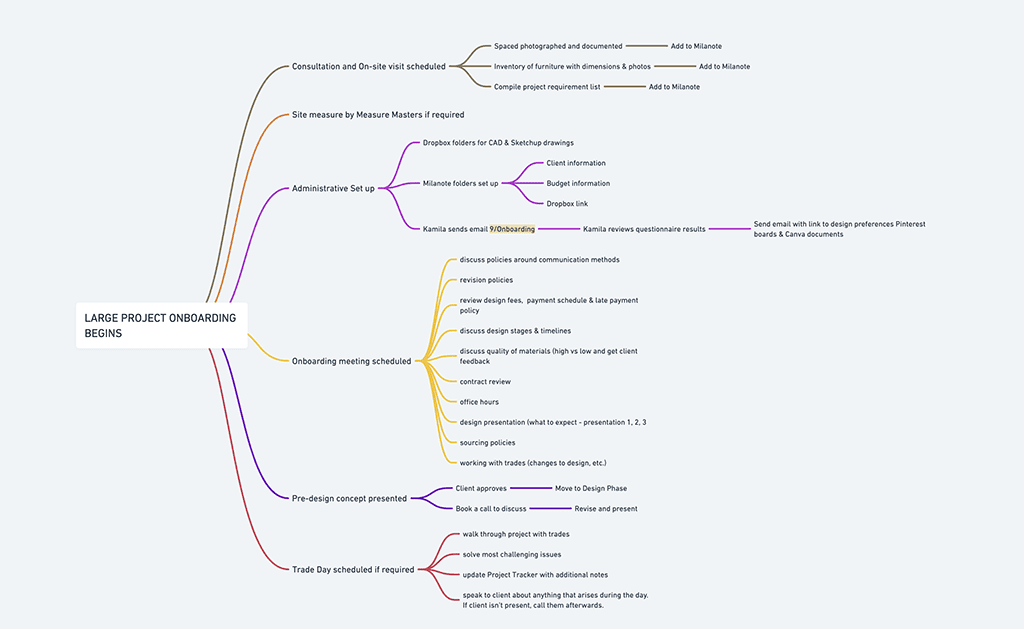
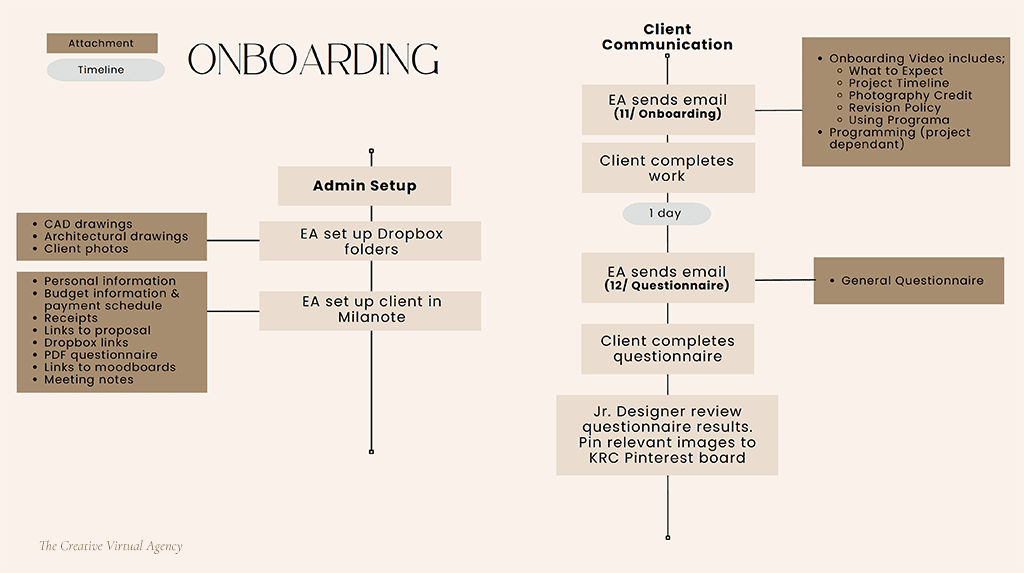
WHAT TO INCLUDE IN A WORKFLOW FOR INTERIOR DESIGN CLIENTS?
Depending on the size of your business and the type of clients you take on this will vary. Across the board, these are the areas I would recommend including:
- The inquiry phase
- Discovery call
- The consultation
- The onboarding meeting
- Trade day
- Design presentation #1
- Design presentation #2
- Final design presentation
- Offboarding meeting
Even if your workflow only includes a couple of steps in some of these stages it’s important. It creates a framework for your current clients and can be modified and expanded as your business grows.
WHAT IS A WORKFLOW VERSUS A PROCESS?
A workflow is created when you list a sequence of tasks. A process is a broader term that includes the data, the forms, the notifications, the people and the timelines involved to move a client from point A to B.
EXAMPLE: Fabric approval for a client
Workflow = obtaining client approval via sign off, receiving samples, preparing quotes
Process = preparing “Client Sign Off” form for approval, preparing “Request for Fabric Sample” form for supplier. Once you’ve mapped out the workflow you’ll have a clear understanding of which templates are needed in your business. That’s when you’ll really start to see success.
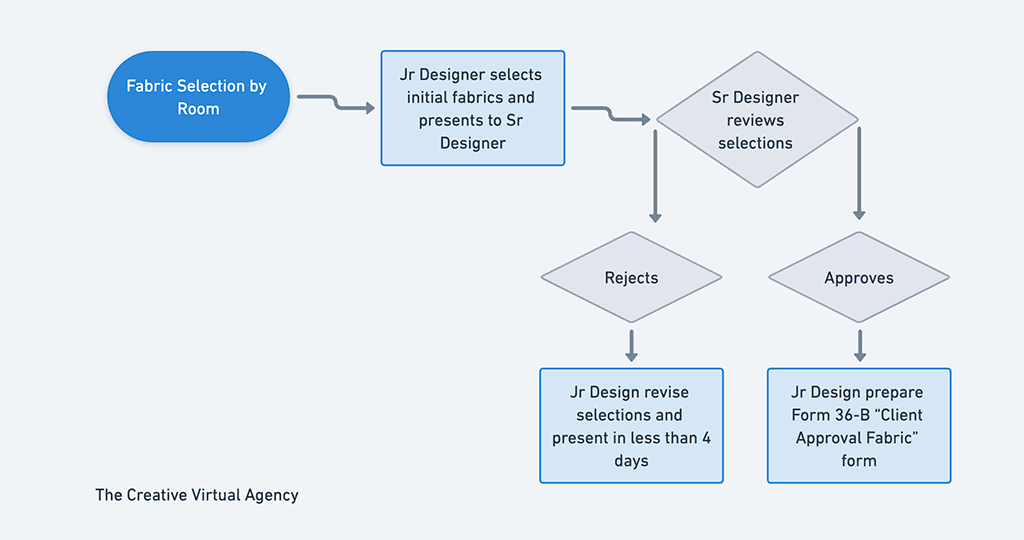
In the workflow illustration above, there is a clear order of tasks to go from sourcing to approval. It accounts for approval and rejection of the initial presentation. It also includes some processes that will be included, i.e. filling out a specific form.
This workflow will help prevent the common issue of dropped workload. I’ve left work incomplete and overdue because there was nobody assigned to take on the task. In the example above, it’s clear that the junior design will do the initial sourcing for fabrics. It’s their responsibility to present and follow up regardless of whether it’s approved or sent for revisions. It also eliminates wasted time checking up on work to be completed.
THE BENEFITS OF A WORKFLOW IN YOUR DESIGN BUSINESS
The biggest benefit you’ll see in your design business when you implement a workflow and systems is that your business becomes a well oiled machine. Every action triggers another action and things keep moving forward.
As opposed to when you run your business without systems in place. Every project feels like reinventing the wheel. You’re wasting time and energy on things that you do every single time and this often leads to feeling overwhelmed.
These are just a few of the benefits you’ll experience when you create a sustainable workflow:
- Create operational efficiency – next steps are evident.
- Saves time – creates productivity gains.
- Eliminate bottlenecks – no need to wait for approval to move ahead with next task.
- Eliminates meetings – processes create a flow to the workload.
- Empower decision making.
I hope this helps you get started on your own workflow. If you need additional help, check out my services page where you can find out more information about how I can help your design business function better in 2025.
If you need some additional documentation to support your operations, visit the template shop.
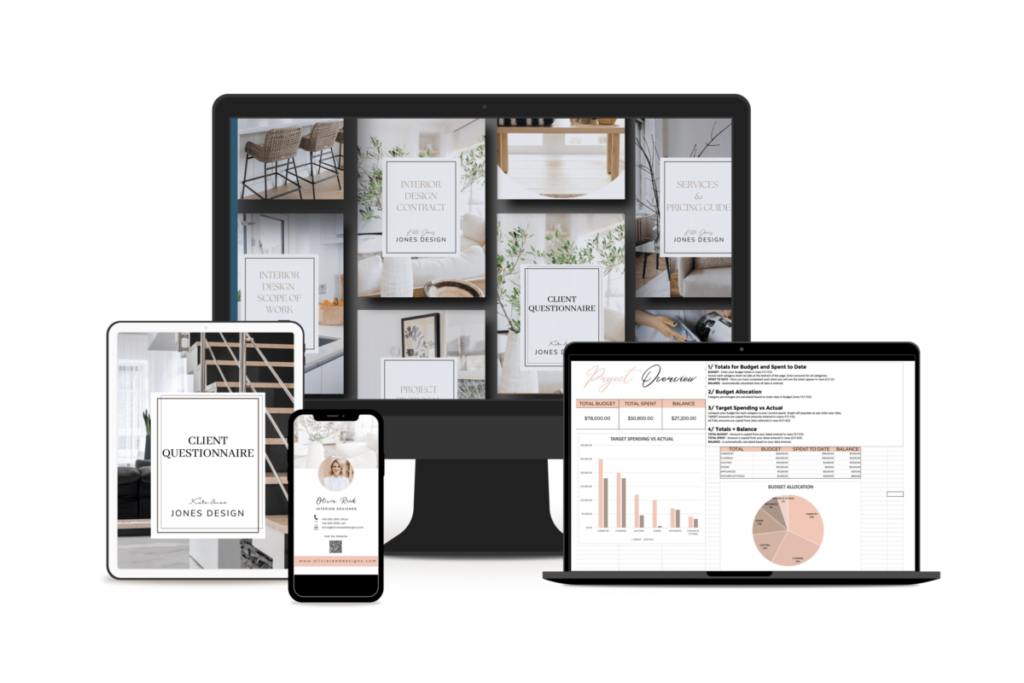
Thanks for reading. I appreciate you and your time.
Carol
Want more business related blog posts: Here are a few you’ll like: